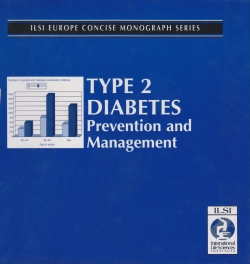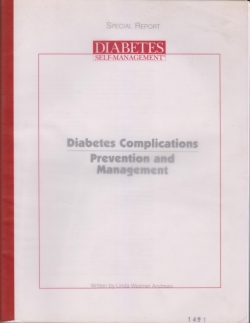Type 2 Diabetes - Prevention and Management

Buy online ($)
Type
Book
Authors
Chaplin ( Steve Chaplin )
ISBN 10
1578811961
Category
Publication Year
2005
Publisher
International Life Sciences Institute, United States
Pages
36
Description
The concise monograph before you outlines basic recommendations for the general population aiming to reduce the risk of a growing epidemic. It also gives an overview of the nutritional aspects to be taken into account when counselling people with diabetes and prediabetic conditions. With the publication of alarming numbers, WHO is not only pointing at the clinical problems of diabetes type 2 patients and at their suffering but is also warning that a pandemic of diabetes type 2 would in the course of a few years, if the growth rate is maintained at today's level, drive all existing health insurance programmes to bankruptcy.
In order to effectively address this issue, it is of extreme importance to understand what the preventive means at our disposal are. Like always, a sound and accessible communication is crucial to put such means into practice. It is in this context that ILSI Europe's concise monograph is expected to contribute.
Recommendations are only efficient if the target population is known. To this end, diagnostic methods have to be improved in order to allow an early diagnosis of pre-diabetic conditions (insulin resistance or insensitivity, impaired fasting glycaemia, impaired glucose tolerance). However, as most individuals with such a condition do not show any disturbing symptoms, they will usually not undergo a test. In addition, present clinical capacities may not be sufficient to allow en masse testing. There is accordingly an urgent need to find new early markers for this pathology, in order to be in an optimal position when recommending preventive measures.
In the future, genomics and metabolomics may help us significantly. To date, the strongest risk factor and marker for type 2 diabetes is overweight and obesity. To control the epidemic we need to reduce calorie intake and increase energy expenditure by increasing physical activity. In order to achieve this, a global and major effort of all stakeholders is urgently required. The food industry can hardly have an impact on energy expenditures, but on the intake side, innovative proposals have already been made and will continuously come up. Many products have been reformulated to be less energy-dense. In many cases this is obtained without losing the product's original palatability. Some have even argued that, in order to become more attractive for consumers, low-density food should be made more palatable than their original counterpart
The importance of taste and, consequently, palatability is central in this debate. Principally sweet taste plays a major role. In nearly all beverages, caloric sweetness could be replaced by non-caloric sweetness, with practically no loss in terms of consumption pleasure. The social and hedonic dimension of food consumption has also to be kept. Beyond these basic measures, one has to keep in mind other factors not mentioned in this concise monograph, like alcohol and tobacco consumption or particular genetic factors.
We hope that many may find this monograph a useful tool: public health authorities, national and European regulators, national nutrition foundations, consumer organizations, industry, those consulted by the public on a daily basis like dieticians or sometimes politicians, as well as the members of the academic world. It can increase their understanding of the major role diet can play in the prevention of diseases, which supports them to accelerate the promotion of a better quality of life through the discovery of a new global change in lifestyle. This can only be obtained by increasing the level of personal responsibility in each individual human.
In order to effectively address this issue, it is of extreme importance to understand what the preventive means at our disposal are. Like always, a sound and accessible communication is crucial to put such means into practice. It is in this context that ILSI Europe's concise monograph is expected to contribute.
Recommendations are only efficient if the target population is known. To this end, diagnostic methods have to be improved in order to allow an early diagnosis of pre-diabetic conditions (insulin resistance or insensitivity, impaired fasting glycaemia, impaired glucose tolerance). However, as most individuals with such a condition do not show any disturbing symptoms, they will usually not undergo a test. In addition, present clinical capacities may not be sufficient to allow en masse testing. There is accordingly an urgent need to find new early markers for this pathology, in order to be in an optimal position when recommending preventive measures.
In the future, genomics and metabolomics may help us significantly. To date, the strongest risk factor and marker for type 2 diabetes is overweight and obesity. To control the epidemic we need to reduce calorie intake and increase energy expenditure by increasing physical activity. In order to achieve this, a global and major effort of all stakeholders is urgently required. The food industry can hardly have an impact on energy expenditures, but on the intake side, innovative proposals have already been made and will continuously come up. Many products have been reformulated to be less energy-dense. In many cases this is obtained without losing the product's original palatability. Some have even argued that, in order to become more attractive for consumers, low-density food should be made more palatable than their original counterpart
The importance of taste and, consequently, palatability is central in this debate. Principally sweet taste plays a major role. In nearly all beverages, caloric sweetness could be replaced by non-caloric sweetness, with practically no loss in terms of consumption pleasure. The social and hedonic dimension of food consumption has also to be kept. Beyond these basic measures, one has to keep in mind other factors not mentioned in this concise monograph, like alcohol and tobacco consumption or particular genetic factors.
We hope that many may find this monograph a useful tool: public health authorities, national and European regulators, national nutrition foundations, consumer organizations, industry, those consulted by the public on a daily basis like dieticians or sometimes politicians, as well as the members of the academic world. It can increase their understanding of the major role diet can play in the prevention of diseases, which supports them to accelerate the promotion of a better quality of life through the discovery of a new global change in lifestyle. This can only be obtained by increasing the level of personal responsibility in each individual human.
Number of Copies
1
| Library | Accession No | Call No | Copy No | Edition | Location | Availability |
|---|---|---|---|---|---|---|
| Main | 1461 | 1 | Yes |




